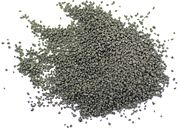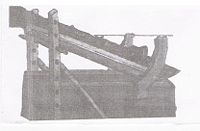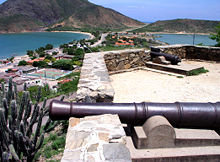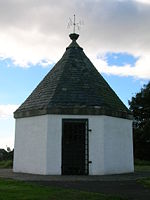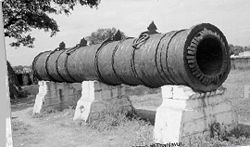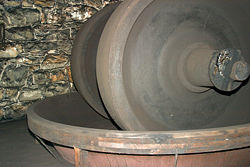Gunpowder
2008/9 Schools Wikipedia Selection. Related subjects: Chemistry
Gunpowder is a an explosive mixture of sulfur, charcoal and potassium nitrate (also known as saltpetre/saltpeter) that burns rapidly, producing volumes of hot solids and gases which can be used as a propellant in firearms and as a pyrotechnic composition in fireworks.
Gunpowder is classified as a low explosive because of its slow decomposition rate and consequently low brisance. Low explosives produce a subsonic deflagration wave rather than the supersonic detonation wave produced by brisants, or high explosives. The gases produced by burning gunpowder generate enough pressure to propel a bullet, but not enough to destroy the barrel of a firearm. This makes gunpowder less suitable for shattering rock or fortifications, where high explosives such as TNT are preferred.
Gunpowder (black powder)
The term "black powder" was coined in the late 19th century to distinguish prior gunpowder formulations from the new smokeless powders and semi-smokeless powders. (Semi-smokeless powders featured bulk volume properties that approximated black powder in terms of chamber pressure when used in firearms, but had significantly reduced amounts of smoke and combustion products; they ranged in colour from brownish tan to yellow to white. Most of the bulk semi-smokeless powders ceased to be manufactured in the 1920's.)
Black powder is a granular mixture of
- a nitrate—typically potassium nitrate (KNO3)—which supplies oxygen for the reaction;
- charcoal, which provides fuel for the reaction in the form of carbon (C);
- sulfur (S), which, while also a fuel, lowers the temperature of ignition and increases the speed of combustion.
Potassium nitrate is the most important ingredient in terms of both bulk and function because the combustion process releases oxygen from the potassium nitrate, promoting the rapid burning of the other ingredients. To reduce the likelihood of accidental ignition by static electricity, the granules of modern black powder are typically coated with graphite, which prevents the build-up of electrostatic charge.
The current standard composition for black powder manufactured by pyrotechnicians was adopted as long ago as 1780. It is 75% potassium nitrate, 15% softwood charcoal, and 10% sulfur. These ratios have varied over the centuries, and by country, but can be altered somewhat depending on the purpose of the powder.
The burn rate of black powder can be changed by corning. Corning first compresses the fine black powder meal into blocks with a fixed density (1.7 g/cm³). The blocks are then broken up into granules. These granules are then sorted by size to give the various grades of black powder. In the USA, standard grades of black powder run from the coarse Fg grade used in large bore rifles and small cannon though FFg (medium and smallbore rifles), FFFg (pistols), and FFFFg (smallbore, short pistols and priming flintlocks). In the United Kingdom, the gunpowder grains are categorised by mesh size: the BSS sieve mesh size, being the smallest mesh size on which no grains were retained. Recognised grain sizes are Gunpowder 'G 7', 'G 20', 'G 40', and 'G 90'.
A simple, commonly cited, chemical equation for the combustion of black powder is
A more accurate, but still simplified, equation is
The products of burning do not follow any simple equation. One study's results showed that it produced (in order of descending quantities): 55.91% solid products: potassium carbonate, potassium sulfate, potassium sulfide, sulfur, potassium nitrate, potassium thiocyanate, carbon, ammonium carbonate. 42.98% gaseous products: carbon dioxide, nitrogen, carbon monoxide, hydrogen sulfide, hydrogen, methane, 1.11% water.
Black powder formulations where the nitrate used is sodium nitrate tend to be hygroscopic, unlike black powders where the nitrate used is saltpetre. Because of this, black powder which uses saltpetre can be stored unsealed and remain viable for centuries provided no liquid water is ever introduced; muzzleloaders have been known to fire after hanging on a wall for decades in a loaded state, provided they remained dry. By contrast, powder that uses sodium nitrate, which is typically intended for blasting, must be sealed from moisture in the air to remain stable for long times.
Advantages
Smokeless powder requires precise loading of the charge to prevent damage due to overloading. With black powder, though such damage is still possible, loading can generally be carried out using volumetric measures rather than precise weight.
Generally, high explosives are preferred for shattering rock; however, because of its low brisance, black powder causes fewer fractures and results in more usable stone compared to other explosives, making black powder useful for blasting monumental stone such as granite and marble.
Black powder is well suited for blank rounds, signal flares, burst charges, and rescue-line launches.
Gunpowder can be used to make fireworks by mixing with chemical compounds that produce the desired colour.
Disadvantages
Black powder has relatively low energy density compared to modern smokeless powders and produces a thick smoke that can impair aiming and reveal a shooter's position.
Combustion converts less than half the mass of black powder to gas; the rest ends up as a thick layer of soot inside the barrel. In addition to being a nuisance, the residue from burnt black powder is hygroscopic and an anhydrous caustic substance. When moisture from the air is absorbed, the potassium oxide or sodium oxide turns into hydroxide, which will corrode wrought iron or steel gun barrels. Black powder arms must be well cleaned both inside and out to remove the residue.
Transportation
The UN Model Regulations on the Transportation of Dangerous Goods and national transportation authorities, such as United States Department of Transportation, have classified Gunpowder (black powder) as a Group A: Primary explosive substance for shipment because it ignites so easily. Complete manufactured devices containing black powder are usually classified as Group D: Secondary detonating substance, or black powder, or article containing secondary detonating substance, such as "Firework", "Class D Model Rocket Engine", etc, for shipment because they are harder to ignite than loose powder. As explosives, they all fall into the category of Class 1.
Sulfur-free gunpowder
The development of smokeless powders, such as Cordite, in the late 19th century created the need for a spark-sensitive priming charge, such as gunpowder. However, the sulfur content of traditional gunpowders caused corrosion problems with Cordite Mk I and this led to the introduction of a range of sulfur-free gunpowders, of varying grain sizes. They typically contain 70.5 parts of saltpetre and 29.5 parts of charcoal. Like black powder, they were produced in different grain sizes. In United Kingdom, the finest grain was known as sulfur-free mealed powder (SMP). Coarser grains were numbered as sulfur-free gunpowder (SFG n): 'SFG 12', 'SFG 20', 'SFG 40' and 'SFG 90', for example, where the number was a BSS sieve mesh size, being the smallest mesh size on which no grains were retained.
History
China
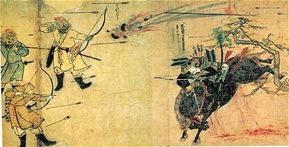
Most sources credit the discovery of gunpowder to Chinese alchemists in the 9th century searching for an elixir of immortality. The discovery of gunpowder was probably the product of centuries of alchemical experimentation. Saltpetre was known to the Chinese by the mid-1st century AD and there is strong evidence of the use of saltpetre and sulfur in various largely medicinal combinations. A Chinese alchemical text from 492 noted that saltpeter gave off a purple flame when ignited, providing for the first time a practical and reliable means of distinguishing it from other inorganic salts, making it possible to evaluate and compare purification techniques.
The first reference to gunpowder is probably a passage in the Zhenyuan miaodao yaolüe, a Taoist text tentatively dated to the mid-800s:
Some have heated together sulfur, realgar and saltpeter with honey; smoke and flames result, so that their hands and faces have been burnt, and even the whole house where they were working burned down.

Contrary to popular belief, the Chinese did not use gunpowder only for fireworks. In fact, the earliest surviving recipes for gunpowder can be found in the Chinese military treatise Wujing zongyao of 1044 AD, which contains three: two for use in incendiary bombs to be thrown by siege engines and one intended as fuel for poison smoke bombs. The formulas in the Wujing zongyao range from 27 to 50 percent nitrate. Experimenting with different levels of saltpetre content eventually produced bombs, grenades, and land mines, in addition to giving fire arrows a new lease on life. By the end of the 12th century, there were cast iron grenades filled with gunpowder formulations capable of bursting through their metal containers. The 14th century Huolongjing contains gunpowder recipes with nitrate levels ranging from 12 to 91 percent, six of which approach the theoretical composition for maximal explosive force.
In China, the 13th century saw the beginnings of rocketry and the manufacture of the oldest gun still in existence, a descendant of the earlier fire-lance, a gunpowder-fueled flamethrower that could shoot shrapnel along with fire. The Huolongjing text of the 14th century also describes hollow, gunpowder-packed exploding cannonballs.
Islamic world
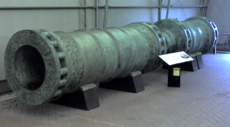
The Arabs acquired knowledge of gunpowder some time after 1240, but before 1280, by which time Hasan al-Rammah had written, in Arabic, recipes for gunpowder, instructions for the purification of saltpeter, and descriptions of gunpowder incendiaries. Khan (1996) argues that invading Mongols introduced gunpowder to the Islamic world.
Though the consensus is that gunpowder originated in China, others have suggested that gunpowder might possibly have been invented by Arabs.
C. F. Temler makes Peter, Bishop of Leon, report the use of cannon in Seville in 1248.
Although gunpowder weapons were employed in the Middle East, they were not always met with open acceptance, as there was some antagonism by the Mamluks of Egypt towards early riflemen in their infantry. The refusal of their Qizilbash forces to use firearms contributed to the Safavid rout at Chaldiran in 1514.
Europe
The earliest extant written references to gunpowder in Europe are from the works of Roger Bacon. In Bacon's Epistola, "De Secretis Operibus Artis et Naturae et de Nullitate Magiae," dated variously between 1248 and 1257, he states:
We can, with saltpeter and other substances, compose artificially a fire that can be launched over long distances... By only using a very small quantity of this material much light can be created accompanied by a horrible fracas. It is possible with it to destroy a town or an army ... In order to produce this artificial lightning and thunder it is necessary to take saltpeter, sulfur, and Luru Vopo Vir Can Utriet.
The last part has been interpreted as an elaborate coded anagram for the quantities needed, but it may also be simply a garbled transcription of an illegible passage.
In the Opus Maior of 1267, Bacon describes firecrackers:
a child’s toy of sound and fire and explosion made in various parts of the world with powder of saltpeter, sulfur and charcoal of hazelwood.
The Liber Ignium, or Book of Fires, attributed to Marcus Graecus, is a collection of incendiary recipes, including some gunpowder recipes. Partington dates the gunpowder recipes to approximately 1300. One recipe for "flying fire" (ingis volatilis) involves saltpeter, sulfur, and colophonium, which, when inserted into a reed or hollow wood, "flies away suddenly and burns up everything." Another recipe, for artificial "thunder", specifies a mixture of one pound native sulfur, two pounds linden or willow charcoal, and six pounds of saltpeter. Another specifies a 1:3:9 ratio.
Some of the gunpowder recipes in the De Mirabilibus Mundi of Albertus Magnus are identical to the recipes of the Liber Ignium, and according to Partington, "may have been taken from that work, rather than conversely." Partington suggests that some of the book may have been compiled by Albert's students, "but since it is found in thirteenth century manuscripts, it may well be by Albert." Albertus Magnus died in 1280 AD.
Shot and gunpowder for military purposes were made by skilled military tradesmen, who later were called firemakers, and who also were required to make fireworks for celebrations of victory or peace. During the Renaissance, two European schools of pyrotechnic thought emerged, one in Italy and the other at Nürnberg, Germany. The Italian school of pyrotechnics emphasized elaborate fireworks, and the German school stressed scientific advancement. Both schools added significantly to further development of pyrotechnics, and by the mid-17th century fireworks were used for entertainment on an unprecedented scale in Europe, being popular even at resorts and public gardens.
By 1788, as a result of the reforms for which Lavoisier was mainly responsible, France had become self-sufficient in saltpeter, and its gunpowder had become both the best in Europe and inexpensive.
The introduction of smokeless powder in the late 19th century led to a contraction of the gunpowder industry.
Britain
Gunpowder production in the British Isles appears to have started in the mid 13th century with the aim of supplying The Crown. Records show that gunpowder was being made, in England, in 1346, at the Tower of London; a powder house existed at the Tower in 1461; and in 1515 three King's gunpowder makers worked there. Gunpowder was also being made or stored at other Royal castles, such as Portchester Castle and Edinburgh castle.
By the early fourteenth century, according to N.J.G. Pounds's study The Medieval Castle in England and Wales, many English castles had been deserted and others were crumbling. Their military significance faded except on the borders. Gunpowder made smaller castles useless.
Henry VIII was short of gunpowder when he invaded France in 1544 and England needed to import gunpowder via the port of Antwerp.
The English Civil War, 1642-1645, led to an expansion of the gunpowder industry, with the repeal of the Royal Patent in August 1641.
The Home Office removed gunpowder from its list of Permitted Explosives; shortly afterwards, on 31 December 1931, Curtis & Harvey's Glynneath gunpowder factory at Pontneddfechan, in Wales, closed down, and it was demolished by fire in 1932.
The last remaining gunpowder mill at the Royal Gunpowder Factory, Waltham Abbey was damaged by a German parachute mine in 1941 and it never reopened. This was followed by the closure of the gunpowder section at the Royal Ordnance Factory, ROF Chorley, the section was closed and demolished at the end of World War II; and ICI Nobel's Roslin gunpowder factory which closed in 1954.
This left the sole United Kingdom gunpowder factory at ICI Nobel's Ardeer site in Scotland; it too closed in October 1976. Since then gunpowder has been imported into the United Kingdom. In the late 1970s / early 1980s gunpowder was bought from eastern Europe; particularly from what were then, East Germany and the former Yugoslavia.
India
Gunpowder arrived in India by the mid-1300s, but could have been introduced by the Mongols perhaps as early as the mid-1200s.
It was written in the Tarikh-i Firishta (1606-1607) that the envoy of the Mongol ruler Hulegu Khan was presented with a dazzling pyrotechnics display upon his arrival in Delhi in 1258 AD. Firearms known as top-o-tufak also existed in the Vijayanagara Empire of India by as early as 1366 AD. From then on the employment of gunpowder warfare in India was prevalent, with events such as the siege of Belgaum in 1473 AD by the Sultan Muhammad Shah Bahmani.
By the 16th century, Indians were manufacturing a diverse variety of firearms; large guns in particular, became visible in Tanjore, Dacca, Bijapur and Murshidabad. Guns made of bronze were recovered from Calicut (1504) and Diu (1533). Gujarāt supplied Europe saltpeter for use in gunpowder warfare during the 17th century. Bengal and Mālwa participated in saltpeter production. The Dutch, French, Portuguese, and English used Chāpra as a centre of saltpeter refining.
War rockets, mines and counter mines using gunpowder were used in India by the time of Akbar and Jahangir. Fathullah Shirazi (c. 1582), a Persian-Indian polymath and mechanical engineer who worked for Akbar the Great in the Mughal Empire, invented the autocannon, the earliest multi-shot gun. As opposed to the polybolos and repeating crossbows used earlier in ancient Greece and China, respectively, Shirazi's rapid-firing gun had multiple gun barrels that fired hand cannons loaded with gunpowder.
Both Hyder Ali and his son Tippu Sultan used black powder technology in iron-cased war rockets with considerable effect against the British, which inspired the development of the Congreve rocket.
United States
Prior to the American Revolutionary War very little gunpowder was made in the United States; and, as a British Colony, most was imported from Britain. In October 1777 the British Parliament banned the importation of gunpowder into America. Gunpowder, however, was secretly obtained from France and the Netherlands.
The first domestic supplies of gunpowder were made by E. I. du Pont de Nemours and Company. The company was founded in 1802 by Eleuthère Irénée du Pont, two years after he and his family left France to escape the French Revolution. They set up a gunpowder mill, the Eleutherian Mills, on the Brandywine Creek at Wilmington, Delaware based on gunpowder machinery bought from France and site plans for a gunpowder mill supplied by the French Government. Starting, initially, by reworking damaged gunpowder and refining saltpetre for the US Government they quickly moved into gunpowder manufacture.
In the United States, saltpetre was worked in the "nitre caves" of Kentucky at the beginning of the 19th century. Tourists at Mammoth Cave, KY to this day are shown the vast deposits of bat guano, as well as the historic machinery use in its extraction and conversion to usable saltpetre for gunpowder from Revolutionary times right up to World War I.
Manufacturing technology
For the most powerful black powder " meal", a wood charcoal is used. The best wood for the purpose is pacific willow, but others such as alder or buckthorn can be used.
The ingredients are mixed as thoroughly as possible. This is achieved using a ball mill with non-sparking grinding apparatus (e.g., bronze or lead), or similar device. Historically, a marble or limestone edge runner mill, running on a limestone bed was used in Great Britain; however, by the mid 19th century this had changed to either an iron shod stone wheel or a cast iron wheel running on an iron bed. The mix is sometimes dampened with alcohol or water during grinding to prevent accidental ignition.
Around the late 14th century, European powdermakers began adding liquid to the constituents of gunpowder to reduce dust and with it the risk of explosion. The powdermakers would then shape the resulting paste of moistened gunpowder, known as mill cake, into "corns", or granules, to dry. Not only did "corned" powder keep better because of its reduced surface area, gunners also found that it was more powerful and easier to load into guns. Before long, powdermakers standardized the process by forcing mill cake through sieves instead of corning powder by hand.
During the 18th century gunpowder factories became increasingly dependent on mechanical energy.
Other uses
Besides its habitual use as an explosive, gunpowder has been occasionally employed for other purposes, After the battle of Aspern-Essling (1809), the surgeon of the Napoleonic Army Larrey combated the lack of food for the wounded under his care by preparing a bouillon of horse meat seasoned with gunpowder for lack of salt.
Brown brown is a form of powdered cocaine, cut with gunpowder. Commonly given to child soldiers in West African armed conflicts, the gunpowder causes irritation of the bowels, which increases aggression.
